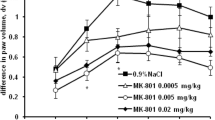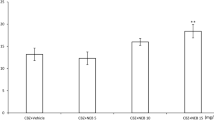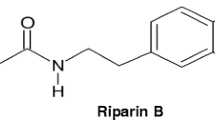Abstract
Valproic acid (VA) is a major antiepileptic drug, used for several therapeutic indications. It has a wide activity spectrum, reflecting on mechanisms of action that are not fully understood. The objectives of this work were to study the effects of VA on acute models of nociception and inflammation in rodents. VA (0.5, 1, 10, 25, and 50 mg/kg, p.o.) effects were evaluated on the carrageenan-induced paw edema, carrageenan-induced peritonitis, and plantar tests in rats, as well as by the formalin test in mice. The HE staining and immunohistochemistry assay for TNF-α in carrageenan-induced edema, from paws of untreated and VA-treated rats, were also carried out. VA decreased paw edema after carrageenan, and maximum effects were seen with doses equal to or higher than 10 mg/kg. VA also preserved the tissue architecture as assessed by the HE staining. Immunohistochemical studies revealed that VA significantly reduced TNF-α immunostaining in carrageenan-inflamed rat paws. In addition, the anti-inflammatory action of VA was potentiated by pentoxifylline (a phosphodiesterase inhibitor, known to inhibit TNF-α production), but not by sodium butyrate or by suberoylanilide hydroxamic acid (SAHA), nonspecific and specific inhibitors, respectively, of histone deacetylase. However, the decrease in the number of positive TNF-α cells in the rat paw was drastically potentiated in the VA + SAHA associated group. VA also reduced leukocytes and myeloperoxidase (MPO) releases to the peritoneal exudate, in the carrageenan-induced peritonitis. Although in the formalin test, VA inhibited both phases, the inhibition was mainly on the second phase. Furthermore, VA significantly increased the reaction time to thermal stimuli, as assessed by the plantar test. VA is a multi-target drug, presenting potent antinociceptive and anti-inflammatory properties at a lower dose range. These effects are partly dependent upon its inhibitory action on TNF-α-related pathways. However, the participation of the HDAC inhibition with the VA anti-inflammatory action cannot be ruled out. Inflammatory processes are associated with free radical damage and oxidative stress, and their blockade by VA could also explain the present results.









Similar content being viewed by others
References
Adcock IM (2007) HDAC inhibitors as anti-inflammatory agents. Br J Pharmacol 150:829–831
Bai G, Wei D, Zou S, Ren K, Dubner R (2010) Inhibition of class II histone deacetylases in the spinal cord attenuates inflammatory hyperalgesia. Mol Pain 6:51–62
Barnes PJ (2006) How corticosteroids control inflammation, Quintiles Prize Lecture 2005. Br J Pharmacol 148:245–254
Berrino L, Oliva P, Massino F, Aurilio C, Maione S, Grella A, Rossi F (2003) Antinociceptive effect in mice of intraperitoneal N-methyl-D-aspartate receptor. Eur J Pain 7:131–137
Biermann J, Griesbaber P, Goebel U, Martin G, Thanos S, Giovanni SD, Lagrèze WA (2010) Valproic acid-mediated neuroprotection and regeneration in injured retinal ganglion cells. Invest Ophthalmology Vision Sci 51:526–534
Cardinale JP, Sriramula S, Pariault R, Guggilam A, Mariapan N, Elks CM, Francis J (2010) HDAC inhibition attenuates inflammatory, hypertrophic and hypertensive responses in spontaneously hypertensive rats. Hypertension 56:437–444
Chen Q, Ouyang DY, Geng M, Xu LH, Zhang YT, Wang FP, He XH (2011) Valproic acid exhibits biphasic effects on apoptotic cell death of activated lymphocytes through differential modulation of multiple signaling pathways. J Immunotoxicol 8:210–218
Chen Y, Boettger MK, Reif A, Schmitt A, Üçeyler N, Sommer C (2010) Nitric oxide synthase modulates CFA-induced thermal hyperalgesia through cytokine regulation in mice. Molecular Pain 6:13–23
Choi JH, Oh SW, Kang MS, Kwon HJ, Oh GT, Kim DY (2005) Trichostatin A attenuates airway inflammation in mouse asthma model. Clin and Exp Allergy 35:89–96
Choi Y, Park S-K, Kim HM, Kang JS, Yoon YD, Han SB, Han JW, Yang JS, Han G (2008) Histone deacetylase inhibitor KBH-A42 inhibits cytokine production in RAW 264.7 macrophage cells and in vivo endoxemia model. Exp and Mol Med 40:574–581
Chung YL, Lee MY, Wang AJ, Yao LF (2003) A therapeutic strategy uses histone deacetylase inhibitors to modulate the expression of genes involved in the pathogenesis of rheumatoid arthritis. Mol Ther 8:707–717
Cunha F, Poole S, Lorenzetti B, Ferreira S (1992) The pivotal role of tumor necrosis factor alpha in the development of inflammatory hyperalgesia. Br J Pharmacol 107:660–664
Dawson J, Sedgwick AD, Edwards JC, Lees P (1991) A comparative study of the cellular, exudative and histological responses to carrageenan, dextran and zymosan in the mouse. IntJ of Tissue Reactants 13:171–185
Dinarello CA (2006) Cytokines as potential therapeutic targets for inflammatory skin diseases. Ernst Schering Found Symp Proc 56:45–60
Di Paola R, Di Marco R, Mazzon E, Genovese T, Bendtzen K, Macrì B, Nicoletti F, Cuzzocrea S (2004) Prevention of carrageenan-induced pleurisy in mice by anti-CD30 ligand monoclonal antibody. Clin Immunol 113:64–73
Eisenberg E, Vos BP, Strassman AM (1993) The NMDA antagonist memantine blocks pain behavior in a rat model of formalin-induced facial pain. Pain 54:301–307
Ferreira S, Lorenzetti B, Bristow A, Poole S (1988) Interleukin-1β as a potent hyperalgesic agent antagonized by a tripeptide analogue. Nature 334:698–700
Furumai R, Ito A, Ogawa K, Maeda S, Saito A, Nishino N, Horinouchi S, Yoshida M (2011) Histone deacetylase inhibitors block nuclear factor-kB-dependent transcription by interfering with RNA polymerase II recruitment. Cancer Sci 102:1081–1087
Gordon SM, Dionne RA, Brahim J, Jabir F, Dubner R (1997) Blockade of peripheral neuronal barrage reduces postoperative pain. Pain 70:209–215
Göttlicher M, Minucci S, Zhu P, Krämer OH, Schimpf A, Giavara S, Sleeman JP, Lo Coco F, Nervi C, Pelicci PG, Heinzel T (2001) Valproic acid defines a novel class of HDAC inhibitors inducing differentiation of transformed cells. EMBO J 20:6969–6978
Gottschalk A, Smith DS, Jobes DR, Kennedy SK, Lally SE, Noble VE, Grugan KF, Seifert HA, Cheung A, Malkowicz SB et al (1998) Preemptive epidural analgesia and recovery from radical prostatectomy: a randomized controlled trial. JAMA 279:1076–1082
Grabiec AM, Krausz S, Jager W, Burakowski T, Groot D, Sanders ME, Prakken BJ, Maslinski W, Eldering E, Tak PP, Reedquist KA (2010) Histone deacetylase inhibitors suppress inflammatory activation of rheumatoid arthritis patient synovial macrophages and tissue. J Immunol 184:2718–2728
Grayson DR, Kundakovic M, Sharma RP (2010) Is there a future for histone deacetylase inhibitors in the pharmacotherapy of psychiatric disorders? Mol Pharmacol 77:126–135
Guay J, Bateman K, Gordon R, Mancini J, Riendeau D (2004) Carrageenan-induced paw edema in rat elicits a predominant prostaglandins E2 (PGE2) response in the central nervous system associated with the induction of microsomal PGE2 synthase-1. J Biol Chem 279:24866–24873
Halili MA, Andrews M, Sweet M, Fairlie DP (2009) Histone deacetylase inhibitors in inflammatory disease. Curr Topics in Med Chem 9:309–319
Ichiyama T, Okada K, Lipton JM, Matsubara T, Hayashi T, Furukawa S (2000) Sodium valproate inhibits production of TNF-alpha and IL-6 and activation of NF-kappaB. Brain Res 857:246–251
Kankaanranta H, Janka-Junttila M, Ilmarinen-Salo P, Ito K, Jalonen U, Ito M, Adcock IM, Moilanen E, Zhang X (2010) Histone deacetylase inhibitors induce apoptosis in human eosinophils and neutrophils. J Inflamm 7:9–23
Kataoka T, Teraoka J, Sakoda A, Nishiyama Y, Yamoto K, Monden M, Ishimori Y, Nomura T, Taguchi T, Yamaoka K (2012) Protective effects of radon inhalation on carrageenan-induced inflammatory paw edema in mice. Inflammation 35:713–722
Khan MIA, Walsh D, Brito-Dellan N (2011) Opioid and adjuvant analgesics: compared and contrasted. Am J Hospital Palliative Care 28:378–383
Krämer OH, Zhu P, Ostendorff HP, Golebiewski M, Tiefenbach J, Peters MA, Brill B, Groner B, Bach I, Heinzel T, Göttlicher M (2003) The histone deacetylase inhibitor valproic acid selectively induces proteasomal degradation of HDAC2. EMBO J 22:3411–3420
Lee IO, Kong MH, Kim NS, Choi YS, Lim SH, Lee MK (2000) Effect of different concentrations and volumes of formalin on pain response in rats. Acta Anaesthesiologica Sinica 38:59–64
Leng Y, Chuang DM (2006) Endogenous α-synuclein is induced by valproic acid through histone deacetylase inhibition and participates in neuroprotection against glutamate-induced excitotoxicity. J Neurosci 26:7502–7512
Leoni F, Fossati G, Lewis EC, Lee JK, Porro G, Pagani P, Modena D, Moras ML, Pozzi P, Reznikov LL et al (2005) The histone deacetylase inhibitor ITF2357 reduces production of pro-inflammatory cytokines in vitro and systemic inflammation in vivo. Mol Med 11:1–15
Leoni F, Zaliani A, Bertolini G, Porro G, Pagani P, Pozzi P, Dona G, Fossati G, Sozzani S, Azam T et al (2002) The antitumor histone deacetylase inhibitor suberoylanilide hydroxamic acid exhibits anti-inflammatory properties via suppression of cytokines. Proc National Acad Sci USA 99:2995–3000
Li W, Zheng L, Sheng C, Cheng X, Qing L, Qu S (2011) Systematic review on the treatment of pentoxifylline in patients with non-alcoholic fatty liver disease. Lipids Health Diseases 10:49
Lin HY, Chen CS, Lin SP, Weng JR, Chen CS (2006) Targeting histone deacetylase in cancer therapy. Med Res Rev 26:397–413
Loram LC, Fuller A, Fick LG, Cartmell T, Poole S, Mitchell D (2007) Cytokine profiles during carrageenan-induced inflammatory hyperalgesia in rat muscle and hind paw. J Pain 8:127–136
Loscher W (2002) Basic pharmacology of valproate: a review after 35 years of clinical use for the treatment of epilepsy. CNS Drugs 16:669–694
Marks PA, Richon VM, Miller T, Kelly WK (2004) Histone deacetylase inhibitors. Ad in Cancer 91:137–168
Marques LJ, Zheng L, Poulakis N, Guzman J, Costabel U (1999) Pentoxifylline inhibits TNF-alpha production from human alveolar macrophages. Am J Respir Crit Care Med 159:508–511
Milutinovic S, D’Alessio AC, Detich N, Szyf M (2006) Valproate induces widespread epigenetic reprogramming which involves demethylation of specific genes. Carcinogenesis 28:560–571
Moradei O, Maroun CR, Paquin I, Vaisburg A (2005) Histone deacetylase inhibitors: latest developments, trends and prospects. Curr Med Chem Anti-Cancer Agents 5:529–560
Nalivaeva NN, Belyaev ND, Turner AJ (2009) Sodium valproate: an old drug with new roles. Trends in Pharmacol Sci 30:509–514
Ni YF, Wang J, Yan XL, Tian F, Zhao JB, Wang YJ, Jiang T (2010) Histone deacetylase inhibitor, butyrate, attenuates lipopolysaccharide-induced acute lung injury in mice. Respir Res 11:33–40
O’Donnell T, Rotzinger S, Nakashima TT, Hanstock CC, Ulrich M, Silverstone PH (2000) Chronic lithium and sodium valproate both decrease the concentration of myoinositol and increase the concentration of inositol monophosphates in rat brain. Brain Res 880:84–91
Ohuchi K, Sato H, Tsurufuji S (1976) The content of prostaglandin E and prostaglandin F2-α in the exudate of carrageenan granuloma of rats. Biochem and Biophys Acta 424:439–448
Perucca E (2002) Pharmacological and therapeutic properties of valproate: a summary after 35 years of clinical experience. CNS Drugs 16:695–714
Phiel CJ, Zhang F, Huang EY, Guenther MG, Lazar MA, Klein PS (2001) Histone deacetylase is a direct target of valproic acid, a potent anticonvulsant, mood stabilizer, and teratogen. J Biol Chem 276:36734–36741
Piovesan EJ, Randunz V, Utiumi M, Lange MC, Kowacs PA, Mulinari RA, Oshinski M, Vital M, Sereniki A, Fernandes AF, Silva LL, Werneck LC (2008) Influence of NMDA and non-NMDA antagonists on acute and inflammatory pain in the trigeminal territory. Arquivos de Neuropsiquiatria 66:837–843
Raza M, Dhariwal MA, Ageel AM, Quresh S (1996) Evaluation of the anti-inflammatory activity of sodium valproate in rats and mice. Gen Pharmacol 27:1395–1400
Roberge RJ, Francis EH (2002) Use of naloxone in valproic acid overdose: case report and review. J Emergency Med 22:67–70
Rocha AC, Fernandes ES, Quintão NL, Campos MM, Calixto JB (2006) Relevance of tumour necrosis factor-alpha for the inflammatory and nociceptive responses evoked by carrageenan in the mouse paw. Br J Pharmacol 148:688–695
Rosenberg G (2007) The mechanisms of action of valproate in neuropsychiatric disorders: can we see the forest for the trees? Cellular Mol and Life Sci 64:2090–2103
Salvamini D, Wang ZQ, Wyatt PS, Bourdon BM, Marino MH, Manning PT, Currie MG (1996) Nitric oxide: a key mediator in the early and late phase of carrageenan-induced rat paw inflammation. Br J Pharmacol 118:829–838
Salvemini D, Zhi-Ojang W, Bourdon DM, Stern MK, Currie MG, Manning PT (1996) Evidence of peroxynitrite involvement in the carrageenan-induced paw edema. Eur J Pharmacol 303:217–220
Sawynok J, Reid A (2002) Modulation of formalin-induced behaviors and edema by local and systemic administration of dextromethorphan, memantine and ketamine. Eur J Pharmacol 450:153–162
Shang Y, Jiang YX, Ding ZJ, Shen AL, Xu SP, Yuan SY, Yao SL (2010) Valproic acid attenuates the multiple-organ dysfunction in a rat model of septic shock. Chinese Med J 123:2682–2687
L-Shin S, Yatham Lakshmi N, Yen Chin-Bin Ravindran Arun V (2005) Effect of valproate on plasma levels of interleukin-6 in health male human. Int Clin Psychopharmacol 20:295–298
Tverskoy M, Oz Y, Isakson A, Finger J, Bradley EL Jr, Kissin I (1994) Preemptive effect of fentanyl and ketamine on postoperative pain and wound hyperalgesia. Anesth Analg 78:205–209
Vaden DI, Ding D, Peterson B, Geenberg MI (2001) Lithium and valproate decrease inositol mass and increase expression of the yeast INO1 and INO2 genes for inositol biosynthesis. J Biol Chem 276:15466–15471
Verri WA Jr, Cunha TM, Parada CA, Poole S, Cunha FQ, Ferreira SH (2006) Hypernociceptive role of cytokines and chemokines: targets for analgesic drug development? Pharmacol Ther 112:116–138
Villar-Garea A, Esteller M (2004) Histone deacetylase inhibitors: understanding a new wave of anticancer drugs. Int J Cancer 112:171–178
Vion-Dury J, Cupo A, Jarry T (1987) Analgesic properties of valproic acid might be related to the encephalin system in rat brain. Brain Res 408:243–246
Watt AP, Schock BC, Ennis M (2005) Neutrophils and eosinophils: clinical implications of their appearance, presence and disappearance in asthma and COPD. Current Drug Targets-Inflammation Allergy 4:415–423
Willmore LJ (2003) Divalproex and epilepsy. Psychopharmacol Bull 37:43–53
Ximenes JCM, Lima-Verde EC, Naffah-Mazzacoratti MG, Viana GSB (2012) Valproic acid, a drug with multiple molecular targets related to its potential neuroprotective action. Neurosci and Med 3:107–123
Zabel P, Schade FU, Schlaak M (1993) Inhibition of endogenous TNF formation by pentoxifylline. Immunobiology 187:447–463
Zakusov VV, Ostrovskaya RU, Bulayev VM (1983) GABA-opiates interactions in the activity of analgesics. Archives of Int Pharmacodynamics and Ther 265:61–75
Acknowledgments
The authors are grateful to the financial support of CNPq and CAPES (Brazilian Government Agencies for financial support and coordination of higher education personnel). They also thank the technical assistance of Ms. Xênia Maria de S. Serra and the orthographic revision of Prof. M.O.L. Viana.
Author information
Authors and Affiliations
Corresponding author
Rights and permissions
About this article
Cite this article
Ximenes, J.C.M., de Oliveira Gonçalves, D., Siqueira, R.M.P. et al. Valproic acid: an anticonvulsant drug with potent antinociceptive and anti-inflammatory properties. Naunyn-Schmiedeberg's Arch Pharmacol 386, 575–587 (2013). https://doi.org/10.1007/s00210-013-0853-4
Received:
Accepted:
Published:
Issue Date:
DOI: https://doi.org/10.1007/s00210-013-0853-4




